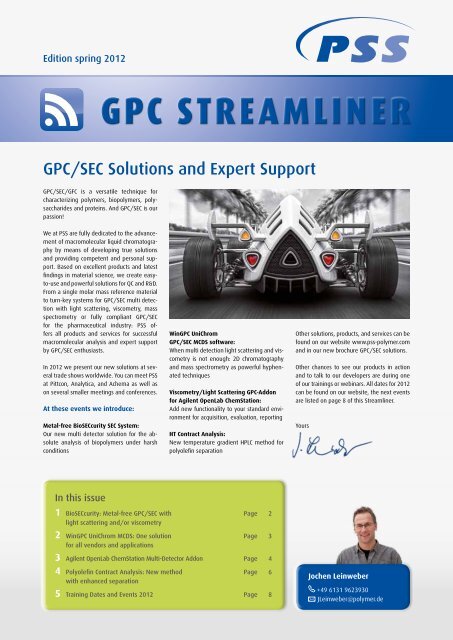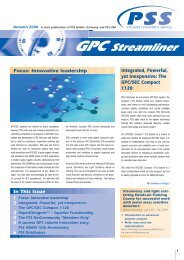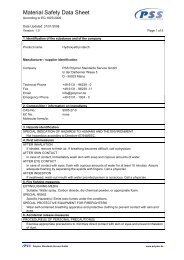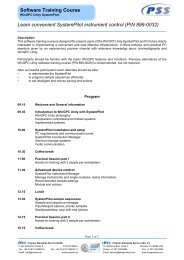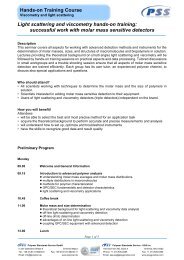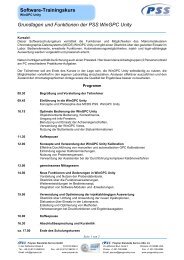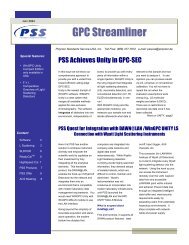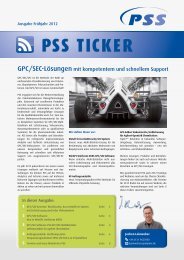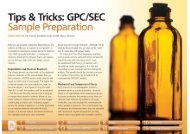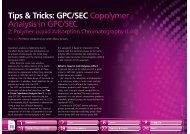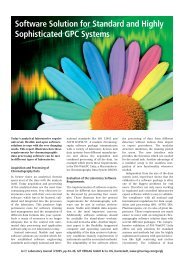GPC STREAMLINER - PSS
GPC STREAMLINER - PSS
GPC STREAMLINER - PSS
Create successful ePaper yourself
Turn your PDF publications into a flip-book with our unique Google optimized e-Paper software.
ToF) has become a new, valuable tool tomeasure true molar masses with high precision,that cannot be determined with anyother method.The disadvantage of <strong>GPC</strong>/SEC-MS hyphenation,the complicated analysis especiallywhen copolymers are present or when multiplecharges per chain are possible, hasbeen overcome with the development ofthe UniChrom Mass Spectrometry Module.Here, mass spectra (in the vendor independentmzXML format) can be imported to thecorresponding Win<strong>GPC</strong> run. The spectra areanalyzed automatically and require only themolar mass of the repetition unit (2 valuesin case of copolymers) and the molar massof the ionization agent as user input. Isotopeeffects in the MS spectra are automaticallycorrected, the charge state in ESI spectra isautomatically determined without any userinteraction. This makes things easy also fornon MS experts.The usability of the Win<strong>GPC</strong> MS module isvery similar to the light scattering, viscometryand 2D modules and can be masteredwithout much effort or long-time training.The data analysis offers many features, dependingon the MS technology employed.These include structure elucidation withMSn, ion-trap and MS-TOF instruments. Even“simple” MS (single quads) generate veryaccurate molar masses which makes themvery useful for absolute molar mass determinationwithout the need to know dn/dc oravoiding copolymers as in light scattering,triple or tetra detection.Dr. Jürgen Paulsdorf+49 6131 9623944JPaulsdorf@polymer.de<strong>GPC</strong>/SEC Software<strong>PSS</strong> <strong>GPC</strong>/SEC Multi-Detector Software for Agilent ChemStationThe <strong>PSS</strong> Win<strong>GPC</strong> product family and Agilent’sChemStation are very popular and widelyused chromatography data systems for<strong>GPC</strong>/SEC and LC, respectively. A <strong>GPC</strong>/SEC addonfor the ChemStation CDS, targeted forroutine applications and limited to concentrationdetectors, is available. However, with theavailability of light scattering (LS) and viscometry(DV) detectors in the Agilent productline after the acquisition of Polymer Labs/Varian, there is a need for a more featurerichChemStation <strong>GPC</strong>/SEC addon, that alsosupports molar mass sensitive detectors.Figure 1Based on the existing solution <strong>PSS</strong> took thelead and developed a fully integrated <strong>GPC</strong>/SEC addon which supports concentrationdetectors, every kind of LS (RALLS, TALLS,MALLS) detectors and online viscometry. Inaddition, the <strong>PSS</strong> Multi-Detector <strong>GPC</strong>/SEC ad-OpenLab CDS ChemStation with activated <strong>PSS</strong> <strong>GPC</strong>/SEC Multi-Detector Addonshowing <strong>GPC</strong>/SEC data from an MDS390 with 2-angle LS and viscometryFigure 2<strong>GPC</strong>/SEC data evalation settings support up to 6signals and conventional, LS, DV and triple detectionsystemsdon offers all kinds of calibration and evaluationmethods incl. narrow and broad standards,universal calibration, viscometry, lightscattering and triple detection.Supported systemsAgilent all 11x0,12x0 systems andmodules, MDS390<strong>PSS</strong> all SECcurity systems anddetectorsother via Agilentdetectors 35900E A/D converterSupported ChemStation revisionsChemStation all 32bit (B.01.01 to B.04.03)OpenLab all CDS CStn (C.01.0x)Supported 32/64 bit Windows platformsWindows XP, Vista, Windows 7,Windows 2008 R2 ServerInstrument control, sequence programming,data evaluation, <strong>GPC</strong>/SEC settings, etc., is alldone within the known ChemStation user interfaceand data formats. ChemStation methods,baselines, peaks and <strong>GPC</strong> data evaluationparameters are used by the <strong>GPC</strong>/SECMulti-Detector Addon to calculate <strong>GPC</strong>/SECresults based on the ChemStation method.The <strong>PSS</strong> <strong>GPC</strong>/SEC Multi-Detector Addon addsa <strong>GPC</strong>/SEC menu to the ChemStation dataanalysis view as shown in Figure 1. Automatedfull or partial sequences, batch analysisand interactive data analysis is supported.IQ and OQ of the software can be done easilyby users with provided verification schemes.The <strong>GPC</strong>/SEC data analysis method supportsall data analysis methods as can be seen inthe dialog depicted in Figure 2.4
The signal type directs data analysis for conventional(RI, UV), light scattering (7°, 15°,90°), viscometry (DP, IP) and triple detectiondata processing.Special data analysis methods like “MultipeakAnalysis” and “Dextran Evaluation” for Pharmacopeiacompliance are also supported.Table 1CurrentData SystemChemStationChemStationNew detector(s)or methodconcentration(e.g. RI, ELS)light scattering(e.g. MDS390, <strong>PSS</strong> SLD1000)Upgraderecommendation<strong>PSS</strong> <strong>GPC</strong>/SEC Addon<strong>PSS</strong> <strong>GPC</strong>/SEC MD AddonThe setup of detector combinations is madeeasy with a detector setup wizard, whichautomatically determines inter detectordelays, calibrates concentration detectors,determines LS instrument constants, measurersLS normalization coefficients, etc.<strong>GPC</strong>/SEC settings are part of the ChemStationmethod. Data processing can be either issuedfrom the <strong>GPC</strong>/SEC menu (“calculate <strong>GPC</strong>results”) or directly from the ChemStationsequence. Figure 3 shows the interactivescreen of a MDS390 triple detector data filewith a VWD as concentration detector for acocktail of narrow calibration standards.ChemStationChemStationWin<strong>GPC</strong>Win<strong>GPC</strong>Win<strong>GPC</strong>Win<strong>GPC</strong>viscometry(e.g. MDS390, <strong>PSS</strong> eta2010)triple detector(e.g. MDS390, <strong>PSS</strong> Triple plus )concentration(all vendors supported)light scattering(all vendors supported)viscometry(all vendors supported)triple detector(all vendors supported)<strong>PSS</strong> <strong>GPC</strong>/SEC MD Addon<strong>PSS</strong> <strong>GPC</strong>/SEC MD Addon<strong>PSS</strong> Win<strong>GPC</strong> UniChrom<strong>PSS</strong> Win<strong>GPC</strong> UniChrom<strong>PSS</strong> Win<strong>GPC</strong> UniChrom<strong>PSS</strong> Win<strong>GPC</strong> UniChromResults can be printed on screen, to PDF, to aphysical printer and can also be transferred toa LIMS or other result management system.Upgrade recommendations for existing installationsThe <strong>PSS</strong> <strong>GPC</strong>/SEC Multi-Detector Addon has aReport Designer option which allows to createuser defined result layouts.Upgrade recommendationsfor existing installationsUsers which already use either system havemore choices now, their previous investmentis always safe and maintained. The table indicatesour upgrade recommendation for userswhich already have an existing data systemand want to process <strong>GPC</strong>/SEC data withconcentration and/or molar mass sensitivedetectors.Figure 3The advantages of using the<strong>PSS</strong> <strong>GPC</strong>/SEC Addonuses well-known ChemStationsoftware environmentintegrates seamlessly intoChemStation/ChemStation OL CDSsame look & feelbased on established and wellsupported productonly incremental software training<strong>PSS</strong> method and Agilentinstrument supporthighest functionality and flexibilitykeep what you have - add whatyou needSince the <strong>PSS</strong> <strong>GPC</strong>/SEC MD Addon, as the Agilent<strong>GPC</strong> Addon, is based on the ChemStationarchitecture, data structures and principles,there are some limitations, which are notpresent in <strong>PSS</strong> Win<strong>GPC</strong> Unity or UniChrom:no database features available as Chem-Station uses a file-based data conceptno true 21CFR11 complianceno 2-dimensional data analysisno <strong>GPC</strong>/SEC-MS data analysisno Heparin (end group) analysisIn such cases the <strong>PSS</strong> Win<strong>GPC</strong> UniChromsoftware is the natural upgrade path whichrequires minimal user training to overcomeAddon limitations. <strong>PSS</strong> Win<strong>GPC</strong> UniChrom canread all ChemStation data files which ensuresthat existing data can be reviewed and reanalyzedif required.Peter KilzInteractive data analysis and result screen of a calibration mixture run on an AgilentMDS390 triple detector system with LS (pink), viscometry (blue) and UV (red)+49 6131 9623940pkilz@polymer.de5
Contract AnalysisNew temperature gradient HT-HPLC method for polyolefin separationFigure 1Many polyolefins differ not only in their molecularweight distribution, but also in theircomposition (PP, PE-olefin copolymers, PE)and morphology (HDPE, LDPE, LLDPE).The molecular weight distribution can be determinedby <strong>GPC</strong>/SEC. However, since <strong>GPC</strong>/SEC separates according to hydrodynamic volumeand not to molecular weight, polyolefinblends of different composition may not beseparated. Advanced detection techniques,e.g. light scattering or viscometry, cannotovercome this limitation, since they rely onproper separation.One potential solution is the use of a separationmethods based on the crystallinity(e.g. TREF, CRYSTAF, CEF). Another possibilityis to use gradient HPLC, as a method thatseparates according to chemical compositionbased on the interaction between analyteand column material. Method developmentincludes optimizing solvent composition ortemperature.Due to their limited solubility polyolefinshave to be investigated at high temperatures(> 100°C), preferably in solvents such as TCB(1,2,4-trichlorobenzene). Only a few HPLCcolumns are available that can be used withthese conditions. For the new <strong>PSS</strong> method agraphite based hypercarb column was used.In addition to a high temperature resistance,this column shows unique separation power.Due to the special surface chemistry separationdepends not only on the composition ofthe sample, but also on the planarity of themolecules. Applied to polyolefins, this meansthat the separation depends primarily on thelength of the ethene sequences.In high temperature-temperature-gradientinteraction-chromatography(ht-TGIC), thesample is injected at higher temperatureand then cooled down rapidly. This procedureleads to the accumulation of the ethenesegments on the graphite surface. When thetemperature is slowly increased, these segmentsresolve in accordance to their length:short segments elute first at lower temperatures,longer segments elute at higher temperatures.Figure 1 shows several linear polyethyleneswith different molecular weightselute at different volumes/temperatures.Up to a molar mass of about 500 g/mol, theseparation is based on the hydrodynamicvolume (<strong>GPC</strong>/SEC mode). Between 500 toabout 2 000 g/mol, a linear relation is observed,where the elution volume dependson the length of the ethene sequences.Above 20 000 g/mol all chain lengths eluteat approximately the same volume. A separationis not possible any more. The separationbehavior is visualized by the red calibrationcurve in Figure 1.The unique strength of ht-TGIC is shown forthe separation of structurally different polyolefins.Here an infrared detector can beused, since isocratic conditions (eluent TCB)are applied. This allows to determine theconcentration as well as the amount of CH 3 -groups. In this example the CH 3 /CH total ratiowas evaluated. It varied from 0.53 for linearPE to 1.18 for PP (33.3% CH 3 groups).Figure 2ht-TGIC linear PEs of different molecular weight, calibration based on ethene sequence lengthsFigure 2 shows the different behavior ofpolyolefins in ht-TGIC.Pure PP has eluted in approximately 1 mlin pure <strong>GPC</strong>/SEC mode (no interaction).A PE-PP copolymer with low PE contentbehaves similarly, as there are no long PEsegments. Based on the CH 3 /CH total ratioit is possible to distinguish between bothmaterials.HDPE elutes late, because of the long ethenesegments which are adsorbed on thegraphite surface. The measured CH 3 /CH totalratio of 0.53 hereby shows no dependenceon the separation (constant composition).Due to the presence of long chain branching,LDPE has shorter ethene segmentlengths than HDPE. This is reflected by elutionat lower volumes. A higher amountof long chain branching results in earlierelution of LDPE. This is also confirmed bythe observation that the CH 3 /CH total ratiodecreases with the elution volume.ht-TGIC for different types of polyolefins6
Figure 3CH 3 /CH total ratio, a higher proportion of CH 3groups is found. Since the CH 3 /CH total ratioprovides no structure information (length)for the comonomers, substance no. 3 mayalso be an ethene-butene (29% butene), anethene-hexene (48% hexene), or an etheneoctenecopolymer (67% octene).Quantification of the individual componentsreveals the composition: 77.5% LDPE, 15.1%copolymer, and 7.4% paraffin oil.Molar Mass ethene segments [Da]ht-TGIC ethene sequence distribution for a blend and its components (normalized to heigth)A statistical LLDPE (ethylene-butene copolymer)shows a different elution behavior.The random incorporation of long ethenesequences leads to an elution at almostthe same volume as HDPE. With the incorperationof butene, the ethene sequencelength, and thus the elution time, decreases.This continuous change is reflecteddirectly in the CH 3 /CH total ratio, which decreasesalmost linear with increasing elutionvolume.Compared to a random copolymer theelution of a block copolymer in ht-TGIC isdifferent. An example for an ethene-octenblock copolymer is shown. This block copolymeris subject of further investigations(2D Chromatography) to reveal all relevantinformation.Because of the unique release mechanismht-TGIC can be used to separate POlyoLEFINblends when separation by HT-<strong>GPC</strong> fails.Figure 3 shows the ethene segment distributionof an unknown blend.As the overlay with reference substancesshows, the sample is a blend of the 3 substancesparaffin oil, LDPE, and a statisticalcopolymer. Paraffin oil is strictly separatedaccording to <strong>GPC</strong>/SEC mode and elutes first.The main component, LDPE, has an averageethene sequence of about 2 500 g/mol. Thethird component can be identified as an statisticalcopolymer. It behaves like an etheneoctenecopolymer with approximately 33%octene. However, when determining theSummary:ht-TGIC combined with IR detection providesa powerful method for the separationof polyolefins based on their structure. Thefact that it separates strictly according to theethene sequence length makes it an ideal alternativefor the separation of olefin blends,when HT-<strong>GPC</strong> cannot be applied. In additionto the separation structural parameters canbe determined. This allows to assign thepolymer type.Dr. Peter Montag+49 6131 9623953pmontag@polymer.de<strong>PSS</strong> Polefin HT-<strong>GPC</strong> ColumnsFor HT-<strong>GPC</strong> separations of poly(ethylene),poly(propylene), and other polyolefins in TCB,o-DCB or Decalin.Particle size: Standard: 10 µm,others on requestMaximumTemperature: 200 °CMaximum 100-150 bar dependingPressure: on porosityRecommendedFlowrate: 0.5-1 mL/minMaximumFlowrate: 2 mL/minApplicable withlight scatteringdetectors: YesAvailable are analytical columns(8 mm ID x 300 mm length) with thefollowing porosities:Part number* (Poly(styrene) based)Porosity [Å]poa0830101e2 100 100 - 10 000poa0830101e3 1 000 100 - 60 000Recommended column combinations:low molar masses: 1 000 + 1 000 + 1 000 Åmedium molar masses: 1 000 + 100 000 + 1 000 000 Åhigh molar masses: 1 000 + 100 000 + 10 000 000 ÅMolar mass separationrange* [Da]poa0830101e5 100 000 1 000 - 1 000 000poa0830101e6 1 000 000 1 000 - 4 000 000poa0830101e7 10 000 000 5 000 - 30 000 000poa0830101lim linear M 100 - 1 000 000poa083010lxl linear XL 1 000 – 4 000 000poa080510PrecolumnTest also our HighSpeed Columns!7
<strong>PSS</strong> Events 2012*Face-to-face training Web-based Training Conferences/Trade Shows<strong>GPC</strong>/SEC TrainingSeptember 20. - 21. 2012Hands-on Visco/LSJune 27. - 28. 2012Software TrainingWin<strong>GPC</strong> Report DesignerSeptember 10. 2012Win<strong>GPC</strong> Basic TrainingSeptember 11. 2012Win<strong>GPC</strong> Viscometry/Light ScatteringSeptember 12. 2012Win<strong>GPC</strong> ChromPilotSeptember 13. 2012Win<strong>GPC</strong> Compliance PackSeptember 14. 2012Single day booking available.User meetingsColumn user meetingOctober 16. 2012Win<strong>GPC</strong> user meetingOctober 17. 2012 - free of chargeEcoSEC user meetingOctober 18. 2012 - free of chargeAll seminars in Mainz, GermanyWebinars <strong>GPC</strong>/SEC Basic TrainingMay 09. - 10. 2012, 11:00 AM EDTOctober 24. - 25. 2012, 11:00 AM EDTWebinars Win<strong>GPC</strong> RefresherBasic Win<strong>GPC</strong> Refresher:June 15. 2012, 11:00 AM EDTOctober 10. 2012, 11:00 AM EDTAdvanced Win<strong>GPC</strong> Refresher:June 16. 2012, 11:00 AM EDTOctober 11. 2012, 11:00 AM EDTThe Viscometry, Light Scattering,Triple detection Win<strong>GPC</strong> Refresher:June 17. 2012, 11:00 AM EDTOctober 11. 2012, 11:00 AM EDT<strong>PSS</strong> Webinars2D Polymer Analysis:April 25. 2012It’s magic. The <strong>PSS</strong> Column Concept:May 24. 2012April 17. – 20. 2012Analytica 2012 in München/GermanyHall A1, Booth 223June 18. – 22. 2012ACHEMA 2012 in Frankfurt/GermanyHall 4.1, Booth P48June 27. – 28. 2012Separation Science 2012in Kuala Lumpur/MalaysiaOral presentation by Adrian WilliamsAugust 19. – 23. 2012ACS Fall National Meeting & Expositionin Philadelphia, PA/USABoothDecember 02. – 03. 2012Advanced Materials by Modular Strategies:From Synthesis to Industrial Application,Houffalize/BelgiumOral presentation by Thorsten Hofe* Official language: EnglishNew <strong>PSS</strong> employeeSince September 2011 Dr. Michael Möller is working for <strong>PSS</strong>.He is responsible for method development,method transfer, the installation of <strong>GPC</strong>/SEC systemsand for supporting our customers worldwide.Michael studied chemistry at theUniversity of Münster and finished hisPhD about the synthesis of peptidepolymer conjugates in February 2011.Dr. Michael Möller+49 6131 9623943MMoeller@polymer.deContact<strong>PSS</strong> Polymer Standards Service GmbHIn der Dalheimer Wiese 555120 Mainz, GermanyPhone: +49 6131 96239-0Fax: +49 6131 96239-11Email: info@polymer.deBeNeLuxPostbox 66330 AA Valkenburg, The NetherlandsPhone: +31 43 4591717Email: hbock@polymer.de<strong>PSS</strong> Polymer Standards Service-USAAmherst Fields Research Park160 Old Farm Rd, Suite AAmherst, MA 01002 USAPhone: +1 413 835 0265Fax: +1 413 835 0354E-mail: info@pssgpcshop.comwww.polymer.de<strong>PSS</strong> has representatives in the following countries:Austria, China, Croatia, Czech Republik, Denmark, Finland, France, Greece, Great Britain, India, Ireland, Israel, Italy, Japan,Korea (south), Mexico, Norway, Poland, Portugal, Russia, Slovakia, Slovenia, South Africa, Spain, Sweden, Taiwan, Turkey


